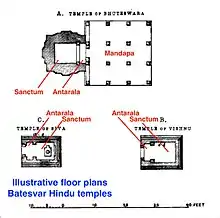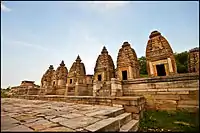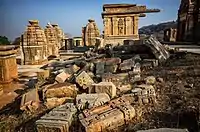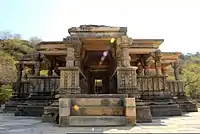Bateshwar Hindu temples, Madhya Pradesh
The Bateshwar Hindu temples (or Batesara, Bateśvar) are a group of nearly 200 sandstone Hindu temples and their ruins in north Madhya Pradesh in post-Gupta, early Gurjara-Pratihara style of North Indian temple architecture.[1] It is about 35 kilometres (22 mi) north of Gwalior and about 30 kilometres (19 mi) east of Morena town. The temples are mostly small and spread over about 25 acres (10 ha) site. They are dedicated to Shiva, Vishnu and Shakti - representing the three major traditions within Hinduism. The site is within the Chambal River valley ravines, on the north-western slope of a hill near Padavali known for its major medieval era Vishnu temple. The Bateshwar temples were built between the 8th and the 10th-century.[1] The site is likely named after the Bhuteshvar Temple, the largest Shiva temple at the site. It is also referred to as Batesvar temples site or Batesara temples site.[2][3]
| Bateshwar Hindu temples | |
|---|---|
.jpg.webp) A few of the 200 Hindu temples in Batesvar | |
| Religion | |
| Affiliation | Hinduism |
| District | Morena district |
| Deity | Shiva, Vishnu, Devi, others |
| Location | |
| Location | Padavali, Chambal Valley |
| State | Madhya Pradesh |
| Country | India |
 Shown within India  Bateshwar Hindu temples, Madhya Pradesh (Madhya Pradesh) | |
| Geographic coordinates | 26°25′37.4″N 78°11′48.6″E |
| Architecture | |
| Style | Nagara |
| Completed | 8th to 11th-century, during Gurjara-Pratihara Empire[1] |
The temples as they now appear are in many cases reconstructed from the fallen stones in a project begun by the Archaeological Survey of India in 2005.
History
According to Madhya Pradesh Directorate of Archaeology, this group of 200 temples were built during the reign of Gurjara-Pratihara Dynasty.[4] According to Michael Meister, an art historian and a professor specializing in Indian temple architecture, the earliest temples in the Bateshwar group near Gwalior are likely from the 750-800 CE period.[5]
The temples were destroyed after the 13th century; it is not clear if this was by an earthquake, or Muslim forces.[1] The site was visited and its ruins reported by Alexander Cunningham in 1882 as a "collection of more than 100 temples large and small to the southeast of Paravali Padavali", the latter with a "very fine old temple".[6] Bateshwar was notified by Archaeological Survey of India (ASI) as a protected site in 1920. Limited recovery, standardized temple numbering, ruins isolation with photography, and site conservation effort was initiated during the colonial British era. Several scholars studied the site and included them in their reports. For example, the French archeologist Odette Viennot published a paper in 1968 that included a discussion and photographs of the numbered Batesvar temples.[3]
In 2005, the ASI began an ambitious project to collect all the ruins, reassemble them and restore as many temples as possible, under an initiative led by the ASI Bhopal region's Superintending Archaeologist K.K. Muhammed.[1] Under Muhammed's leadership, some 60 temples were restored. Muhammed has continued to campaign for the site's further restoration and calls it "my place of pilgrimage. I come here once in every three months. I am passionate about this temple complex."[1]
According to Muhammed, the Bateshwar complex was "built on the architectural principles enunciated in two Sanskrit Hindu temple architecture texts, Manasara Shilpa Shastra composed in the 4th century CE, and Mayamata Vastu Shastra written in the 7th century CE".[1] He followed these texts as his team of over 50 workers collected pieces of the ruins from the site and like a jigsaw puzzle tried to put it back together.[1] The site has been a "massive mounds of rubble" of temple parts, states Subramanian, with "ruins lying everywhere".[1]
Dacoit Nirbhay Singh Gujjar and his gang helped Archaeological Survey of India restore the temple complex.[7]
Description
The site is mentioned in historical literature as Dharon or Paravali, later as Padavali. The local name for the group of temples is Batesvar or Bateshwar temples.[1][6]

According to the Cunningham's report of 1882, the site was a "confused assemblage of more than one hundred temples of various sizes, but mostly small". The largest standing temple was of Shiva, wrote Cunningham, and the temple was locally called Bhutesvara. However, to his surprise the temple had a relief of Garuda on top, leading him to speculate that the temple may have been a Vishnu temple before it was damaged and reused. The Bhutesvara temple had a square sanctum with a 6.75 feet (2.06 m) side, with a relatively small 20 square feet mahamandapa. The sanctum doorway was flanked by river goddesses Ganga and Yamuna. The tower superstructure was a pyramidal square starting off from a 15.33 feet (4.67 m) sided square seated on a flat roof, then rhythmically tapering off.[6]
The standing temples, stated Cunningham, all had sides made from single slabs set upright, above which sat flat roofs then pyramidal top as a part of their architecture.[6] The site had a water tank cut into the hill rock, with rows of small temples arranged to form a street to the tank. Cunningham also reported seeing Shiva linga inside one of the temples, a trimurti statue, a Ganesha, Shiva and Parvati together around this temple.[6] Next to the Shiva temple was a Vishnu temple, about the same size as the Siva temple, again a square sanctum of 6.67 feet (2.03 m) side with river goddesses Ganga and Yamuna flanking the doorway on its jambs.[6]
In north-northeast corner of the site was a large platform of about 42.67 feet (13.01 m) length and 29.67 feet (9.04 m) breadth, with an integrated platform projection of a square with 11.67 feet (3.56 m) side. Cunningham speculated that this may have been the largest temple at the Bateshvara site before its destruction, and he noted that not a stone remains near the platform to offer further clues as to what the lost temple was like.[6] Cunningham also noted that one of the small temples to the northwest of the Bhuteshwara temple had a short inscription dated Samvat 1107 (1050 CE), thus establishing the floruit for the site.[6]
The ASI team ruins identification and restoration efforts since 2005 have yielded the following additional information about the site:[1]
- Some of the temples had a Nataraja on the kirti-mukha
- Reliefs with "exquisite carving" of Lakulisa
- Reliefs of Siva holding the hand of Parvati
- Reliefs narrating the legend of Kalyana-sundaram, or the marriage of Shiva and Parvati with Vishnu, Brahma and others attending
- Small sculptures of women playing the lute, veena or drums in Vishnu temples, suggesting that music profession in pre-11th century India encouraged women to participate as musicians
- Amorous couples in various stages of courtship and intimacy (mithuna, kama scenes)
- Secular scenes such as men riding elephants, men wrestling, lions
- Friezes with narratives from the Bhagavata Purana such as Krishna leela scenes such as Devaki holding baby Krishna who is suckling her breasts in prison that is guarded by a woman; Baby Krishna draining away the life of the demon with poisoned breasts, etc.
According to Gerd Mevissen, the Batesvar temples complex has many interesting lintels, such as one with Navagraha, many with Dashavatara (ten avatars of Vishnu) of the Vaishnavism tradition, frequent display of Saptamatrikas (seven mothers) from the Shaktism tradition.[2] The presence of Navagraha lintel suggests, states Mevissen, that the temple complex must be dated after 600 CE. The diversity of the theological themese at the site suggest that Batesvar (also called Batesara) was once a hub for temple-related arts and artists.[2]
Significance
According to Michael Meister, the Bateshwar site illustrates the conception and construction of "Mandapika shrine" concept in central India.[8] It is reducing the Hindu temple idea to its basics, in a simple concept that is one step further from the single cave cell design. This design has roots in more ancient Hindu temples found in this region such as one that survives at Mahua and has a Sanskrit inscription that calls the design as sila mandapika (literally, a "stone pandal or pavilion". This has vedi-platform roots that combines the traditional square plan with various combinations of Hindu temple architecture elements. The temples explore a square sanctum mounted on a basement platform (jagati) that is rectangular, states Meister, so as to incorporate a small praggriva (porch).[8] These temples have a "simple pillared wall topped by a broad, flat-edged awning which extends beyond the sanctum to shade the entry as well. The square pillars rest directly on the vedibandha, and are crowned by "leaf capitals, their shafts engraved with decorative medallions. At its best this type has a very individual and decorative quality, still like a wooden or ivory box, intervening bands of meandering foliage especially vital, the whole framed by the flat, deeply shadowed vedibandha mouldings and the crisp chadya (with saw-tooth edge) above", according to Meister. The significance of these temples is that they fuse and experiment with a variety of temple building ideas, such as topping the nagara sikharas that may have been dominant by that time possibly in western India, on the simplest of temple grid plans with more ancient roots in central India.[8]
Gallery
 Ruins at the Batesvar site
Ruins at the Batesvar site Restored temples
Restored temples.jpg.webp) Two similar temples, some differences
Two similar temples, some differences.jpg.webp) Water tank and stacked ruins
Water tank and stacked ruins Ruins and different temple styles
Ruins and different temple styles Vishnu temple at Batesvar
Vishnu temple at Batesvar.jpg.webp) Vishnu temple interior from ruins
Vishnu temple interior from ruins.jpg.webp) Vishnu temple, recreated by ASI
Vishnu temple, recreated by ASI
See also
References
- Subramanian, T.S. (16–29 January 2010). "Restored Glory". Frontline, Volume 27 – Issue 02. Retrieved 17 January 2010.
- Dietrich Boschung; Corinna Wessels-Mevissen (2012). Figurations of Time in Asia. Wilhelm Fink. pp. 82–97. ISBN 978-3-7705-5447-8.
- O. VIENNOT (1968), Le problème des temples à toit plat dans l'Inde du Nord, Arts Asiatiques, Vol. 18 (1968), École française d’Extrême-Orient, pages 40-51 with Figures 50, 53-56, 76, 80-82 and 88 context: 23-84 (in French)
- Madhya Pradesh (India)-Directorate of Archaeology & Museums (1989). Puratan, Volumes 6–7. Dept. of Archaeology and Museums, Madhya Pradesh. p. 113.
- Michael W. Meister (1976), Construction and Conception: Maṇḍapikā Shrines of Central India, East and West, Vol. 26, No. 3/4 (September - December 1976), page 415, Figure 21 caption, context: 409-418
- Eastern Rajputana Tour Report, A Cunningham, Archaeological Survey of India, Volume XX, pages 107, 110-112
- "ASI to resume restoration of Bateshwar temple complex in Chambal". Hindustan Times. 21 May 2018.
- Michael W. Meister (1976), Construction and Conception: Maṇḍapikā Shrines of Central India, East and West, Vol. 26, No. 3/4 (September - December 1976), pages 415-417, context: 409-418
Bibliography
- Prasanna Kumar Acharya (2010). An encyclopaedia of Hindu architecture. Oxford University Press (Republished by Motilal Banarsidass). ISBN 978-81-7536-534-6.
- Prasanna Kumar Acharya (1997). A Dictionary of Hindu Architecture: Treating of Sanskrit Architectural Terms with Illustrative Quotations. Oxford University Press (Reprinted in 1997 by Motilal Banarsidass). ISBN 978-81-7536-113-3.
- Vinayak Bharne; Krupali Krusche (2014). Rediscovering the Hindu Temple: The Sacred Architecture and Urbanism of India. Cambridge Scholars Publishing. ISBN 978-1-4438-6734-4.
- Alice Boner (1990). Principles of Composition in Hindu Sculpture: Cave Temple Period. Motilal Banarsidass. ISBN 978-81-208-0705-1.
- Alice Boner; Sadāśiva Rath Śarmā (2005). Silpa Prakasa. Brill Academic (Reprinted by Motilal Banarsidass). ISBN 978-8120820524.
- A.K. Coomaraswamy; Michael W. Meister (1995). Essays in Architectural Theory. Indira Gandhi National Centre for the Arts. ISBN 978-0-19-563805-9.
- Dehejia, V. (1997). Indian Art. Phaidon: London. ISBN 0-7148-3496-3.
- Adam Hardy (1995). Indian Temple Architecture: Form and Transformation. Abhinav Publications. ISBN 978-81-7017-312-0.
- Adam Hardy (2007). The Temple Architecture of India. Wiley. ISBN 978-0470028278.
- Adam Hardy (2015). Theory and Practice of Temple Architecture in Medieval India: Bhoja's Samarāṅgaṇasūtradhāra and the Bhojpur Line Drawings. Indira Gandhi National Centre for the Arts. ISBN 978-93-81406-41-0.
- Harle, J.C., The Art and Architecture of the Indian Subcontinent, 2nd edn. 1994, Yale University Press Pelican History of Art, ISBN 0300062176
- Monica Juneja (2001). Architecture in Medieval India: Forms, Contexts, Histories. Orient Blackswan. ISBN 978-8178242286.
- Stella Kramrisch (1976). The Hindu Temple Volume 1. Motilal Banarsidass (Reprinted 1946 Princeton University Press). ISBN 978-81-208-0223-0.
- Stella Kramrisch (1979). The Hindu Temple Volume 2. Motilal Banarsidass (Reprinted 1946 Princeton University Press). ISBN 978-81-208-0224-7.
- Michael W. Meister; Madhusudan Dhaky (1986). Encyclopaedia of Indian temple architecture. American Institute of Indian Studies. ISBN 978-0-8122-7992-4.
- George Michell (1988). The Hindu Temple: An Introduction to Its Meaning and Forms. University of Chicago Press. ISBN 978-0-226-53230-1.
- George Michell (2000). Hindu Art and Architecture. Thames & Hudson. ISBN 978-0-500-20337-8.
- T. A. Gopinatha Rao (1993). Elements of Hindu iconography. Motilal Banarsidass. ISBN 978-81-208-0878-2.
- Ajay J. Sinha (2000). Imagining Architects: Creativity in the Religious Monuments of India. University of Delaware Press. ISBN 978-0-87413-684-5.
- Burton Stein (1978). South Indian Temples. Vikas. ISBN 978-0706904499.
- Burton Stein (1989). The New Cambridge History of India: Vijayanagara. Cambridge University Press. ISBN 978-0-521-26693-2.
- Burton Stein; David Arnold (2010). A History of India. John Wiley & Sons. ISBN 978-1-4443-2351-1.
- Kapila Vatsyayan (1997). The Square and the Circle of the Indian Arts. Abhinav Publications. ISBN 978-81-7017-362-5.
External links
 Media related to Bateshwar Temple Complex at Wikimedia Commons
Media related to Bateshwar Temple Complex at Wikimedia Commons

